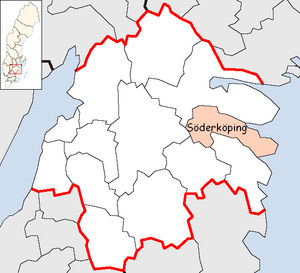Söderköping Municipality facts for kids
Quick facts for kids
Söderköping Municipality
Söderköpings kommun
|
||
|---|---|---|
 |
||
|
||
 |
||
| Country | Sweden | |
| County | Östergötland County | |
| Seat | Söderköping | |
| Area | ||
| • Total | 1,329.47 km2 (513.31 sq mi) | |
| • Land | 677.92 km2 (261.75 sq mi) | |
| • Water | 651.55 km2 (251.56 sq mi) | |
| Area as of January 1, 2010. | ||
| Population
(June 30, 2012)
|
||
| • Total | 14,062 | |
| • Density | 10.5771/km2 (27.3947/sq mi) | |
| Time zone | UTC+1 (CET) | |
| • Summer (DST) | UTC+2 (CEST) | |
| ISO 3166 code | SE | |
| Province | Östergötland | |
| Municipal code | 0582 | |
| Website | www.soderkoping.se | |
Söderköping Municipality (Söderköpings kommun) is a special area in Östergötland County in southeast Sweden. It's like a local government area. The main town where the local government is located is called Söderköping.
This municipality was created between 1971 and 1973. The old City of Söderköping joined with three smaller areas nearby to form the municipality we know today.
Contents
Understanding Söderköping's Population
This section helps us learn about the people living in Söderköping Municipality. We can see how many people live in different parts of the municipality and learn a bit about them.
How Many People Live Here?
- In 2022, there were 11,419 Swedish citizens old enough to vote living in the municipality.
- The total number of residents in each area varies, for example, Drothem had 2,183 residents, while Sankt Anna-Börrum had 781.
Who Works and Studies?
- Most adults (between 20 and 64 years old) in Söderköping Municipality are working and pay taxes. For example, in Drothem, 89% of people in this age group were employed.
- Many people in Söderköping also have a college degree or higher education. In Drothem, 46% of adults had a degree, which is quite high!
Where Do People Come From?
- Most people living in Söderköping Municipality were born in Sweden, and their parents were also born in Sweden.
- However, there are also people with a "foreign heritage," meaning they were born abroad or their parents were. For example, in Alboga, 15% of residents had foreign heritage.
How People Vote in Söderköping
Elections are how people choose their leaders. In Sweden, people vote for members of the Riksdag, which is like their parliament. This section shows how people in Söderköping Municipality have voted over the years.
Voting for the Riksdag
People in Söderköping Municipality have voted in national elections since 1973. The "Turnout" shows how many people actually voted. "Votes" means the number of valid votes counted.
- In the 1973 election, about 92.3% of eligible voters cast their ballots.
- In the 2014 election, the turnout was even higher, at 88.3%.
- Different political parties get different amounts of votes. For example, in 2014, the Social Democrats (S) received 27.0% of the votes, and the Moderate Party (M) received 26.0%.
Political Groups and Their Support
Political parties often form groups or "blocs" with similar ideas. In Sweden, there are generally two main blocs:
- Left Bloc: This group usually includes parties like the Social Democrats, Left Party, and Green Party.
- Right Bloc: This group often includes parties like the Moderate Party, Centre Party, Liberals, and Christian Democrats.
The Sweden Democrats (SD) are a separate party that has grown in popularity over time.
- In the 1973 election, the Left bloc received 37.5% of the votes, while the Right bloc received 59.3%.
- In the 2018 election, the Left bloc had 48.5% of the votes, and the Right bloc had 35.0%. The Sweden Democrats received 14.0% of the votes in that election.
Images for kids
-
Söderköping lock on the Göta Canal
See also
 In Spanish: Municipio de Söderköping para niños
In Spanish: Municipio de Söderköping para niños





